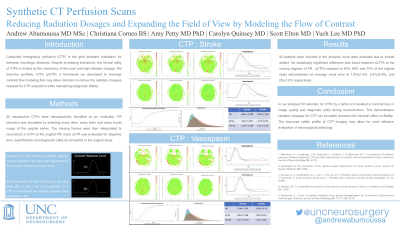Synthetic CT Perfusion Scans: Reducing Radiation Dosages and Expanding the Field of View by Modeling the Flow of Contrast
Friday, April 21, 2023


Andrew L. Abumoussa, MD MSc
Neurosurgery Resident, PGY-5
University of North Carolina
Chapel Hill, North Carolina, United States
ePoster Presenter(s)
Introduction: Computed tomography perfusion (CTP) is the gold standard evaluation for ischemic neurologic diseases. Despite increasing indications, the clinical utility of CTPs is limited by the mechanics of the scan and high radiation dosage. We describe synthetic CTPs (sCTP), a framework we developed to leverage contrast flow modeling that may allow clinicians to reduce the radiation dosages required for CTP acquisition while maintaining diagnostic fidelity.
Methods: 40 consecutive CTPs were retrospectively identified at our institution. FR reduction was simulated by selecting every other, every third, and every fourth image of the original series. The missing frames were then interpolated to reconstruct a sCTP at the original FR. Each sCTP was evaluated for objective error quantification and diagnostic utility as compared to the original study.
Results: 40 patients were included in the analysis; none were excluded due to motion artifact. No statistically significant difference was found between sCTPs at the varying degrees of FR . sCTPs sampled at 50%, 66% and 75% of the original study demonstrated an average voxel error of 1.8%±1.8%, 0.4%±5.8%, and 0%±1.9% respectively.
Conclusion : In our analysis FR reduction for CTPs by a factor of 4 resulted in minimal loss in image quality and diagnostic utility during reconstruction. This demonstrates radiation dosages for CTP can be safely reduced with minimal effect on fidelity. The improved safety profile of CTP imaging may allow for more effective evaluation of neurosurgical pathology.
Methods: 40 consecutive CTPs were retrospectively identified at our institution. FR reduction was simulated by selecting every other, every third, and every fourth image of the original series. The missing frames were then interpolated to reconstruct a sCTP at the original FR. Each sCTP was evaluated for objective error quantification and diagnostic utility as compared to the original study.
Results: 40 patients were included in the analysis; none were excluded due to motion artifact. No statistically significant difference was found between sCTPs at the varying degrees of FR . sCTPs sampled at 50%, 66% and 75% of the original study demonstrated an average voxel error of 1.8%±1.8%, 0.4%±5.8%, and 0%±1.9% respectively.
Conclusion : In our analysis FR reduction for CTPs by a factor of 4 resulted in minimal loss in image quality and diagnostic utility during reconstruction. This demonstrates radiation dosages for CTP can be safely reduced with minimal effect on fidelity. The improved safety profile of CTP imaging may allow for more effective evaluation of neurosurgical pathology.
